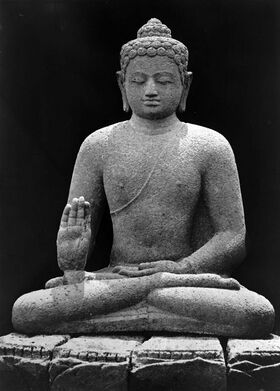Religion:Amoghasiddhi
| Amoghasiddhi | |
|---|---|
 Statue of Amogasiddha from Borobudur, Central Java, Indonesia | |
| Sanskrit | अमोघसिद्धि Amoghasiddhi |
| Chinese | 不空成就佛 (Pinyin: Bùkōngchéngjiù Fó) |
| Japanese | (romaji: Fukūjōju Butsu) |
| Khmer | អមោឃសិទ្ធិ (UNGEGN: Âmoŭkhôsĕtthĭ) |
| Korean | 불공성취불 (RR: Bulgongseongchwi Bosal) |
| Mongolian script | ᠲᠡᠭᠦᠰ ᠨᠥᠭᠴᠢᠭᠰᠡᠨ Үйлс бүтээгч (SASM/GNC: Tegüs nögcigsen) |
| Thai | พระอโมฆสิทธิพุทธะ Phraamoksitthiphuttha |
| Tibetan | དོན་ཡོད་གྲུབ་པ་ Wylie: don yod grub pa THL: dönyö drubpa |
| Vietnamese | Bất Không Thành Tựu Phật |
| Information | |
| Venerated by | Mahāyāna, Vajrayāna |
Amoghasiddhi (Devanagari: अमोघसिद्धि) is one of the Five Wisdom Buddhas of the Mahayana and Vajrayana tradition of Buddhism. He is associated with the accomplishment of the Buddhist path and of the destruction of the poison of envy. His name means Unfailing Accomplishment. His consort is Tara, meaning Liberator and his mounts are garudas. He belongs to the family of karma whose family symbol is the double vajra.[1][2]
Characteristics
Amoghasiddhi is associated with the conceptual (Skt: samskara) skandha or the conceptual mind (as opposed to the non-conceptual or sensational mind). His action towards the promotion of Buddhist paths is the pacification of evils. This is symbolised by Amoghasiddhi's symbol, the moon. He gestures in the mudra of fearlessness, symbolising his and his devotees' fearlessness towards the poisons or delusions.
He is usually coloured green in artwork and is associated with the air or wind element. His season is autumn and his heavenly quarter is the northern buddha-kṣetra called Prakuta.
In the Śūraṅgama mantra (Chinese: 楞嚴咒; pinyin: Léngyán Zhòu) taught in the Śūraṅgama sutra (Chinese: 楞嚴經; pinyin: Léngyán Jīng), an especially influential dharani in the Chinese Chan tradition, Amoghasiddhi is mentioned to be the host of the Karma Division in the North, one of the five major divisions which controls the vast demon armies of the five directions.[3]
Gallery
-
Jin dynasty (1115–1234) statue of Amoghasiddhi in Shanhua Temple in Datong, Shanxi, China , one out of a set of statues of the Five Tathagathas
-
Ming dynasty (1368–1644) statue of Amoghasiddhi in Huayan Temple in Datong, Shanxi, China , one out of a set of statues of the Five Tathagathas
-
Ming dynasty figurine of Amoghasiddhi, made during the reign of the Yongle Emperor, early 1400s
-
Tian Tan Buddha, a large bronze statue of Amoghasiddhi, located at Ngong Ping, Lantau Island, in Hong Kong. The statue is 34 metres (112 ft) tall, weighs over 250 metric tons (280 short tons)
-
Amoghasiddhi, depicted with green skin
-
Close up view of Amoghasiddhi from a Tibetan painting, 1300–1400 CE
See also
- Five Dhyani Buddhas
References
- ↑ Double Dorje
- ↑ "The Five Dhyani Buddhas (Great Buddhas of Wisdom)". Religionfacts.com. 2012-12-21. http://www.religionfacts.com/buddhism/deities/five_dhyani_buddhas.htm. Retrieved 2013-06-14.
- ↑ The Śūraṅgama sūtra : a new translation. Hsüan Hua, Buddhist Text Translation Society. Ukiah, Calif.: Buddhist Text Translation Society. 2009. ISBN 978-0-88139-962-2. OCLC 300721049. https://www.worldcat.org/oclc/300721049.
Further reading
- Mythology of India: Myths of India, Sri Lanka and Tibet, Rachel Storm, Anness Publishing Limited, Editor Helen Sudell, Page 15, Column 2–4, Line 5, Caption, Page 15, Column 4, Lines 1 – 5
External links
- Symbolism of the five Dhyani Buddhas
- Sacred Visions: Early Paintings from Central Tibet, an exhibition catalog from The Metropolitan Museum of Art (fully available online as PDF), which contains material on Amoghasiddhi(see index)
 |







